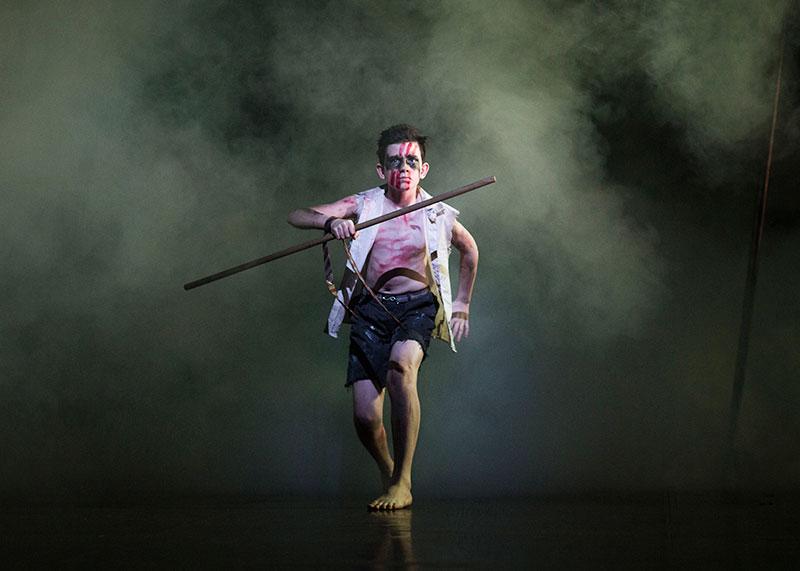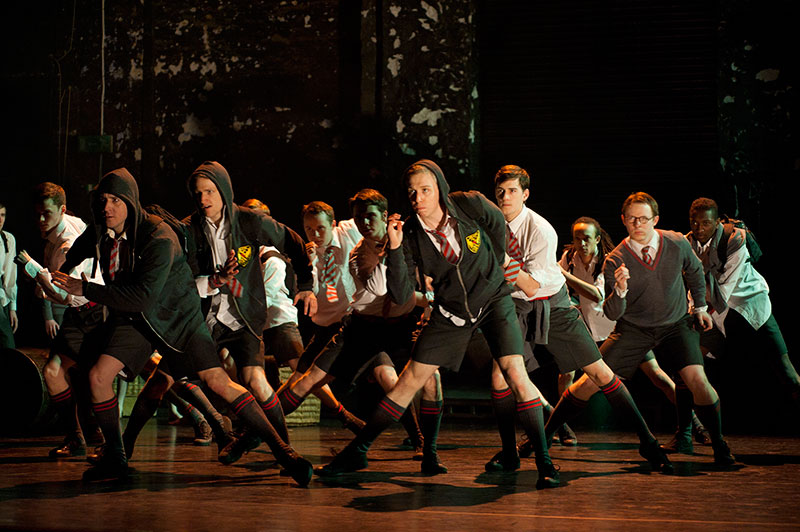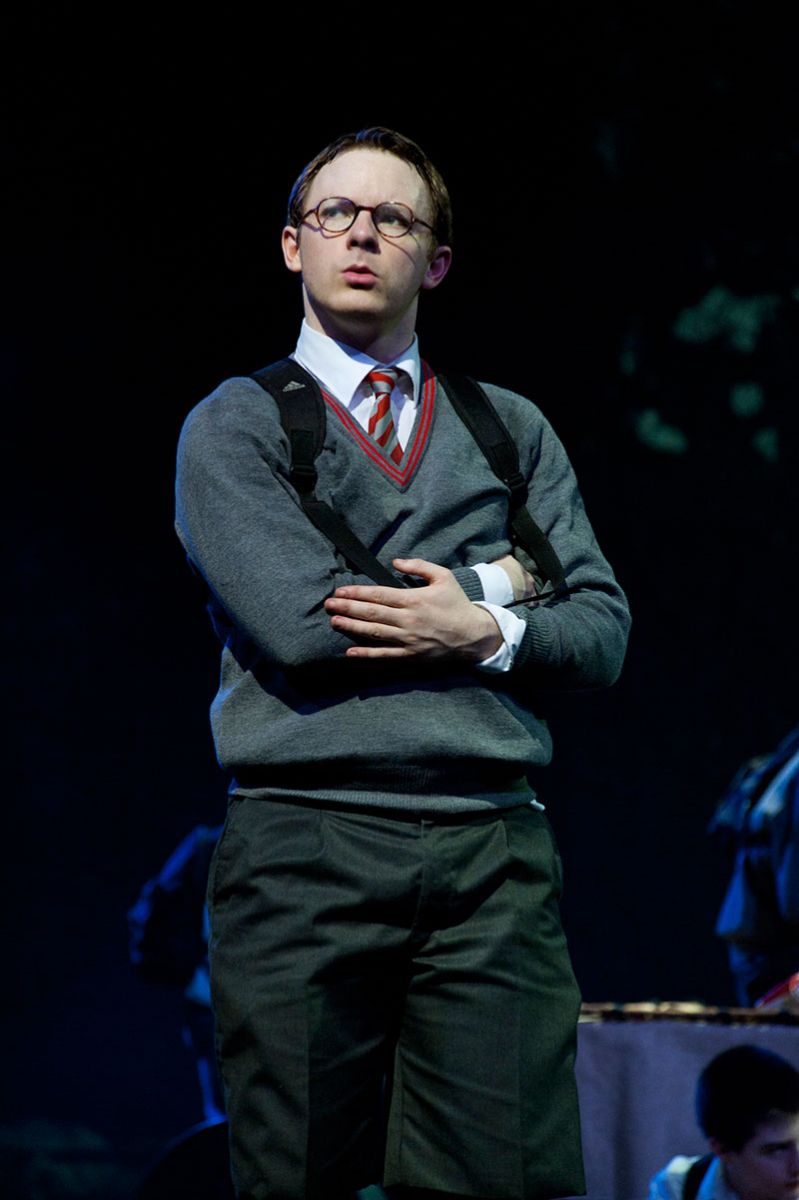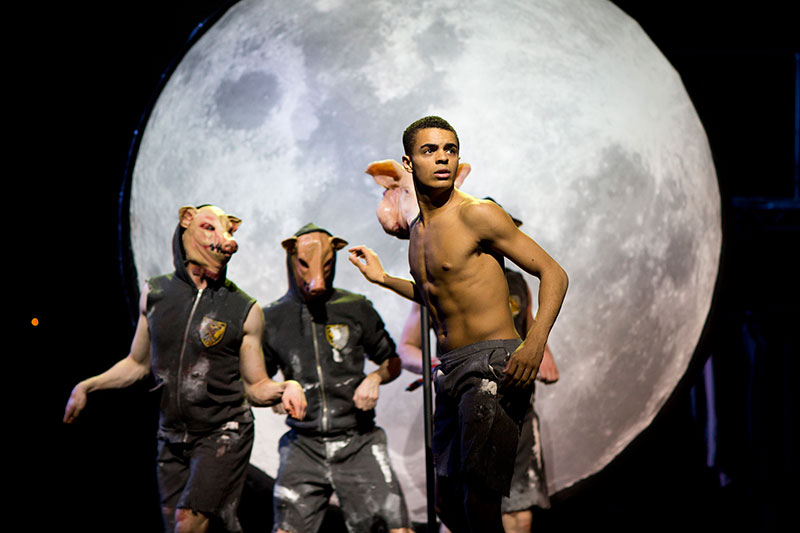Lord of the Flies, Matthew Bourne's New Adventures, Sadler's Wells | reviews, news & interviews
Lord of the Flies, Matthew Bourne's New Adventures, Sadler's Wells
Lord of the Flies, Matthew Bourne's New Adventures, Sadler's Wells
Golding's tale of schoolboy savagery becomes superb dance theatre, with real schoolboys

New Adventures, the name of Matthew Bourne's company, has a ruddy-cheeked, Boys’ Own ring to it that has – until now – been rather belied by his oeuvre, which includes a dance version of Edward Scissorhands, as well as dark retellings of all the traditional story ballets.
Civilization and barbarism are complex terms, and political philosophers of a pessimistic cast – most prominently Jean-Jacques Rousseau – have been at pains to point out that so-called civilized people, with all their art and technology, are potentially a lot more barbaric than tribal societies on desert islands. The arts and sciences are a double-edged sword, just as capable of driving degeneration as of exalting or refining – something Golding makes clear in his novel, where advances in technology (sharpening sticks, levering rocks) are just as deadly as night terrors and collective hysteria. Yet just by writing the novel, Golding also offers a more hopeful view of the value of art to instruct and improve human nature. Matthew Bourne, one of Britain’s most accomplished and intelligent makers of dance theatre, has met this challenge to art head-on, not only setting his version of the story in a deserted theatre, but engaging modern schoolboys to act and dance in it.
 The other that “civilized” adults in Britain demonise is often young and male: the hoodie, the disaffected yoof, the London rioter of 2012, the knife-wielding gang member. Bourne challenges those stereotypes by mounting an incredibly impressive, powerful, professional dance show using a cast of 20-plus local boys and young men chosen by audition in each city the tour visits. These amateur casts give fantastic performances, merging seamlessly with the small group of professional dancers playing the main parts, and amply demonstrate the ability of young men to be just as disciplined and professional as anyone else.
The other that “civilized” adults in Britain demonise is often young and male: the hoodie, the disaffected yoof, the London rioter of 2012, the knife-wielding gang member. Bourne challenges those stereotypes by mounting an incredibly impressive, powerful, professional dance show using a cast of 20-plus local boys and young men chosen by audition in each city the tour visits. These amateur casts give fantastic performances, merging seamlessly with the small group of professional dancers playing the main parts, and amply demonstrate the ability of young men to be just as disciplined and professional as anyone else.
They also look like they’re having a fabulously good time on stage, and if the 6000-odd men and boys who have taken part in the impressive programme of workshops that has accompanied this tour have enjoyed their experience of dance and storytelling even half as much, Bourne and his collaborators have done a really fantastic thing for dance outreach.
 But all the worthiness in the world doesn’t guarantee a good show – so I am pleased to report that more or less none of the above was passing through my head during the performance last night. It is, quite simply, fabulous theatre: gripping from first to last, exciting, highly affecting (I cried), and unforgettable. No need to have read the novel: it’s all there in dance. We meet chubby, bespectacled Piggy (Sam Plant, pictured left), Ralph (Sam Archer), the good leader, handsome but wavering, the bad chief Jack (Danny Reubens) as a swaggering hoodie (nice touch), and the rest in their neat school uniforms, and watch with mounting horror as factions emerge and become increasingly violent.
But all the worthiness in the world doesn’t guarantee a good show – so I am pleased to report that more or less none of the above was passing through my head during the performance last night. It is, quite simply, fabulous theatre: gripping from first to last, exciting, highly affecting (I cried), and unforgettable. No need to have read the novel: it’s all there in dance. We meet chubby, bespectacled Piggy (Sam Plant, pictured left), Ralph (Sam Archer), the good leader, handsome but wavering, the bad chief Jack (Danny Reubens) as a swaggering hoodie (nice touch), and the rest in their neat school uniforms, and watch with mounting horror as factions emerge and become increasingly violent.
We see the boys capering wildly with glee at first, then shivering with fear: their descent into savagery is genuinely discomfiting, as - casting off their uniforms - they rampage noisily over the stage, grunting and shouting, holding up a severed pig’s head that glistens redly. Terry Davies's score is a mix of melody and noise that echoes and illustrates the warring of good and bad in human nature: angelic choirboys contrast with squawks and grunts, cello elegies with thumping bass and insistent drumming.
 Bourne fans looking for the polished choreography and dance finesse of his Swan Lake won’t find quite the same thing here: though some of the professional dancers give gorgeous, haunting solos (especially Layton Williams as Simon, pictured right), Bourne has chosen to match the nature of both cast and story with a more naturalistic movement language, using running, and stamping, with a bit of B-boy flair thrown in. It’s executed tremendously well by all, and there is huge power and confidence in the two contrasting ensemble numbers that show the boys’ descent - one at the beginning based on neat, cadet-like marching and accompanied by the sound of boy trebles, and a later one based on heavy, threatening stamping, and accompanied by a soundtrack of grunts and animal noises.
Bourne fans looking for the polished choreography and dance finesse of his Swan Lake won’t find quite the same thing here: though some of the professional dancers give gorgeous, haunting solos (especially Layton Williams as Simon, pictured right), Bourne has chosen to match the nature of both cast and story with a more naturalistic movement language, using running, and stamping, with a bit of B-boy flair thrown in. It’s executed tremendously well by all, and there is huge power and confidence in the two contrasting ensemble numbers that show the boys’ descent - one at the beginning based on neat, cadet-like marching and accompanied by the sound of boy trebles, and a later one based on heavy, threatening stamping, and accompanied by a soundtrack of grunts and animal noises.
I could go on and on – about the cleverness of the theatre set, with its use of costume rails as thickets for Ralph and Piggy to hide behind, about the fantastic acting of the lead parts, about the literal coup de théâtre that kills Piggy. But I simply urge you to go and see for yourself. Bourne has done it again: this is dance theatre at its intelligent, powerful, moving best, and a resounding argument for the power of art to bring out the better side of human nature.
- Lord of the Flies is at Sadler's Wells till 11 October, then touring to Cardiff, Newcastle, Norwich and Bradford.
rating
Explore topics
Share this article
The future of Arts Journalism
You can stop theartsdesk.com closing!
We urgently need financing to survive. Our fundraising drive has thus far raised £33,000 but we need to reach £100,000 or we will be forced to close. Please contribute here: https://gofund.me/c3f6033d
And if you can forward this information to anyone who might assist, we’d be grateful.

Subscribe to theartsdesk.com
Thank you for continuing to read our work on theartsdesk.com. For unlimited access to every article in its entirety, including our archive of more than 15,000 pieces, we're asking for £5 per month or £40 per year. We feel it's a very good deal, and hope you do too.
To take a subscription now simply click here.
And if you're looking for that extra gift for a friend or family member, why not treat them to a theartsdesk.com gift subscription?
more Dance
 Help to give theartsdesk a future!
Support our GoFundMe appeal
Help to give theartsdesk a future!
Support our GoFundMe appeal
 Vollmond, Tanztheater Wuppertal Pina Bausch + Terrain Boris Charmatz, Sadler's Wells review - clunkily-named company shows its lighter side
A new generation of dancers brings zest, humour and playfulness to late Bausch
Vollmond, Tanztheater Wuppertal Pina Bausch + Terrain Boris Charmatz, Sadler's Wells review - clunkily-named company shows its lighter side
A new generation of dancers brings zest, humour and playfulness to late Bausch
 Phaedra + Minotaur, Royal Ballet and Opera, Linbury Theatre review - a double dose of Greek myth
Opera and dance companies share a theme in this terse but affecting double bill
Phaedra + Minotaur, Royal Ballet and Opera, Linbury Theatre review - a double dose of Greek myth
Opera and dance companies share a theme in this terse but affecting double bill
 Onegin, Royal Ballet review - a poignant lesson about the perils of youth
John Cranko was the greatest choreographer British ballet never had. His masterpiece is now 60 years old
Onegin, Royal Ballet review - a poignant lesson about the perils of youth
John Cranko was the greatest choreographer British ballet never had. His masterpiece is now 60 years old
 Northern Ballet: Three Short Ballets, Linbury Theatre review - thrilling dancing in a mix of styles
The Leeds-based company act as impressively as they dance
Northern Ballet: Three Short Ballets, Linbury Theatre review - thrilling dancing in a mix of styles
The Leeds-based company act as impressively as they dance
 Best of 2024: Dance
It was a year for visiting past glories, but not for new ones
Best of 2024: Dance
It was a year for visiting past glories, but not for new ones
 Nutcracker, English National Ballet, Coliseum review - Tchaikovsky and his sweet tooth rule supreme
New production's music, sweets, and hordes of exuberant children make this a hot ticket
Nutcracker, English National Ballet, Coliseum review - Tchaikovsky and his sweet tooth rule supreme
New production's music, sweets, and hordes of exuberant children make this a hot ticket
 Matthew Bourne's Swan Lake, New Adventures, Sadler's Wells review - 30 years on, as bold and brilliant as ever
A masterly reinvention has become a classic itself
Matthew Bourne's Swan Lake, New Adventures, Sadler's Wells review - 30 years on, as bold and brilliant as ever
A masterly reinvention has become a classic itself
 Ballet Shoes, Olivier Theatre review - reimagined classic with a lively contemporary feel
The basics of Streatfield's original aren't lost in this bold, inventive production
Ballet Shoes, Olivier Theatre review - reimagined classic with a lively contemporary feel
The basics of Streatfield's original aren't lost in this bold, inventive production
 Cinderella, Royal Ballet review - inspiring dancing, but not quite casting the desired spell
A fairytale in need of a dramaturgical transformation
Cinderella, Royal Ballet review - inspiring dancing, but not quite casting the desired spell
A fairytale in need of a dramaturgical transformation
 First Person: singer-songwriter Sam Amidon on working in Dingle with Teaċ Daṁsa on 'Nobodaddy'
Michael Keegan-Dolan’s mind-boggling total work of art arrives at Sadlers Wells this week
First Person: singer-songwriter Sam Amidon on working in Dingle with Teaċ Daṁsa on 'Nobodaddy'
Michael Keegan-Dolan’s mind-boggling total work of art arrives at Sadlers Wells this week

Add comment